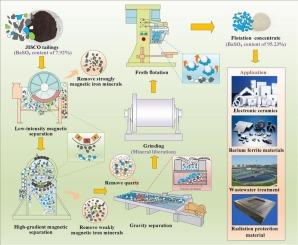从低品位尾矿废物中可持续高效地回收重晶石:资源利用的综合创新解决方案
IF 5
2区 工程技术
Q1 ENGINEERING, CHEMICAL
引用次数: 0
摘要
含重晶石尾矿是一种储量大、可回收性高的二次重晶石资源。为从低品位尾矿废料中高效回收重晶石,提出了一种创新的磁重浮选联合分离工艺。采用弱磁选和高梯度磁选先后去除含磁性铁矿物。非磁性部分随后进行振动台分离,以丢弃低密度脉石矿物,如石英。通过磁选和重选预富集,将BaSO4品位从7.92%提高到74.43%,有效提升了原料质量。这种预富集显著降低了下游浮选的试剂消耗和操作成本。在优化的浮选条件下,获得了BaSO4纯度为95.23%的重晶石精矿,符合中国化工行业重晶石产品一级优等标准。矿物解离分析结果表明,精矿中重晶石含量达95.59%。贫重晶石共生体含量小于0.13%。本研究为工业尾矿中重晶石资源的可持续增值提供了一种有效的策略。本文章由计算机程序翻译,如有差异,请以英文原文为准。

Sustainable and efficient barite recovery from low-grade tailings waste: A combined and innovative solution for resource utilization
Barite-containing tailings represent a secondary barite resource characterized by substantial reserves and high recyclability. In this study, an innovative combined magnetic-gravity-flotation separation process was proposed for efficiently recovering barite from low-grade tailings waste. Low-intensity magnetic separation and high-gradient magnetic separation were sequentially employed to remove magnetic iron-bearing minerals. The non-magnetic fraction was subsequently subjected to shaking table separation to discard low-density gangue minerals, such as quartz. Through pre-enrichment via magnetic and gravity separation, the BaSO4 grade increased from 7.92% to 74.43%, effectively upgrading the raw material quality. This pre-enrichment significantly reduced reagent consumption and operational costs in downstream flotation. Under optimized flotation conditions, a barite concentrate with 95.23% BaSO4 purity was achieved, compliant with the first-class superior specifications outlined in China’s chemical industry standards for barite products. The mineral liberation analysis results indicated that the barite content in the concentrate reached 95.59%. The content of barite-poor intergrowth was less than 0.13%. This research provides a sustainable and efficient strategy for valorizing barite resources in industrial tailings.
求助全文
通过发布文献求助,成功后即可免费获取论文全文。
去求助
来源期刊

Minerals Engineering
工程技术-工程:化工
CiteScore
8.70
自引率
18.80%
发文量
519
审稿时长
81 days
期刊介绍:
The purpose of the journal is to provide for the rapid publication of topical papers featuring the latest developments in the allied fields of mineral processing and extractive metallurgy. Its wide ranging coverage of research and practical (operating) topics includes physical separation methods, such as comminution, flotation concentration and dewatering, chemical methods such as bio-, hydro-, and electro-metallurgy, analytical techniques, process control, simulation and instrumentation, and mineralogical aspects of processing. Environmental issues, particularly those pertaining to sustainable development, will also be strongly covered.
 求助内容:
求助内容: 应助结果提醒方式:
应助结果提醒方式:


